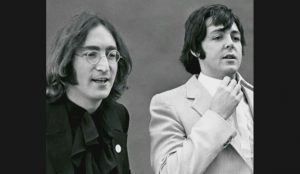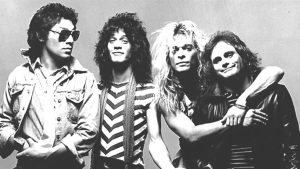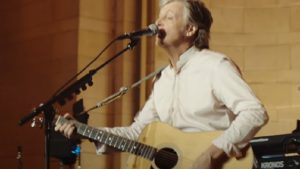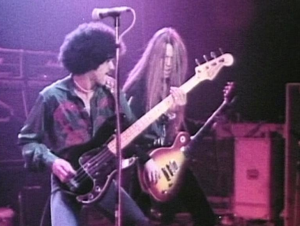15 Of The Most Famous Left-Handed Rockstars
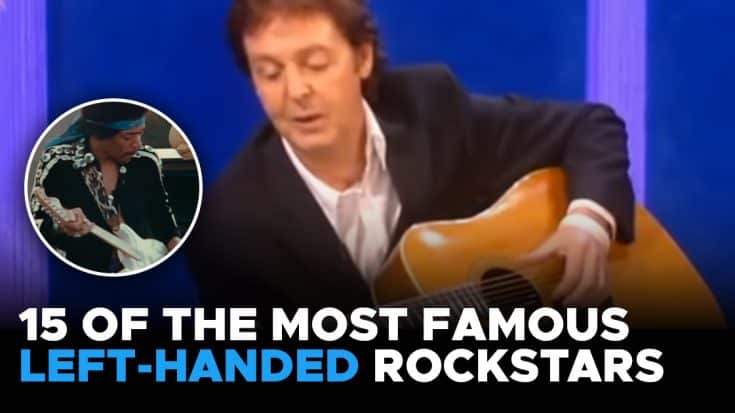
In this predominantly right-handed world, lefties are trying to survive all kinds of inconveniences ranging from classroom armchairs to trying to cut stuff with scissors. But imagine how hard it is to be a left-handed guitarist, especially during the 50s or 60s.
Guitars created for left-handers are very rare, and worse, there’s almost no one to teach lefty guitarists how to properly play the instrument. But this tiny thing did not stop greatness from being achieved.
What’s amazing though, is that a greater portion of left-handed people are gifted musicians. Adapting to normal guitars by re-stringing them or flipping them upside down takes a lot of creativity and patience.
No wonder these guitarists achieve brilliance in spite of being handed a great challenge the moment they were born. Here are 15 of the greatest and most influential left-handed guitar players in history.
1. Gary Moore
The renowned Gary Moore is a virtuoso often overlooked by the masses. Armed with remarkable skills and the capability to harmoniously infuse his guitar playing with passion, Moore seamlessly navigated the rock scene of the 1970s while also finding his place within jazz and blues collectives, collaborating alongside luminaries like Greg Lake from ELP.
Born in Belfast, Ireland, on April 4, 1952, Moore embarked on his guitar journey at the tender age of 8, using a right-handed model and teaching himself chords and lead techniques in the style of Eric Clapton and Peter Green from John Mayall and the Bluesbreakers.
2. Slim Whitman
Despite being naturally right-handed, Slim Whitman, a prominent country music singer-songwriter and musician, opted to play the guitar left-handed due to an accident that cost him a finger on his right hand. This decision was driven by his determination to continue playing rather than giving up on music altogether.
Fortunately, Whitman’s resilience paid off, and he became one of the most influential guitarists of his time. This influence even extended to another esteemed left-handed guitarist, the Beatle Paul McCartney himself. It was said that Paul found guidance and inspiration from a photograph of Whitman playing left-handed during a time when he was unsure about playing a standard guitar.
3. Albert King
In the realm of blues, Albert King commanded immense influence. A left-handed artist, he defied convention by embracing right-handed guitars, often favoring Gibson Flying Vs, and playing them in an inverted manner.
Unlike many fellow left-handed guitarists who either adapted to right-handed playing or reconfigured their instruments, King opted for a unique approach: skillfully maneuvering right-handed guitars flipped over, strings reversed. This unconventional technique propelled the blues maestro to explore novel ways of crafting his desired sound, thus shaping his distinctive blues identity.
4. Elizabeth Cotten
Elizabeth Cotten, born in 1895, was a significant figure in American blues and folk music. She excelled as a musician, vocalist, and songwriter, who left a resounding mark during the era of the roots music revival. Often likened to the female counterpart of Robert Johnson, Cotten was a left-handed guitarist who adeptly navigated a right-handed guitar by inverting it.
This unconventional technique involved employing her fingers for the bass strings and her thumb for the melody, resulting in her distinctive fingerpicking approach. Her trademark “Cotten Picking” method, characterized by alternating bass patterns, along with her story of re-learning guitar as she approached the ripe age of 60, inspired generations of musicians.
5. Robert Fripp
While for many, learning to play the guitar right-handed as a left-handed individual might seem like a hurdle to surmount, such perceptions don’t apply to King Crimson’s frontman, Robert Fripp. In Fripp’s case, this challenge seamlessly transformed into an opportunity, a pivotal factor he attributes to molding his distinct musical style. He once shared with Guitar Player, “I work on the assumption that you have two hands, so why not use each of them.”
This unconventional and innovative mindset certainly helped Fripp stay relevant, and he even scored some popularity cookie points during the COVID-19 lockdowns when he and his wife Toyah recorded and uploaded humorous videos on Youtube. These clips, called Toyah and Robert’s Sunday Lunch, are usually covers of well-known songs
6. Elliot Easton
Cars lead guitarist Elliot Easton remembered acquiring his first guitar when he was just three years old. As a young child during the late 1950s, his fascination with the instrument grew through exposure to cowboys, Elvis Presley, and the Mickey Mouse Club show, where one of the lead Mouseketeers wielded the guitar.
His commitment to learning the guitar deepened at the age of eight, skillfully navigating a right-handed guitar flipped upside down. As his teenage years arrived, he diligently saved funds to finally procure a custom-ordered Fender Telecaster, the first of his left-handed guitars.
7. Dick Dale
Hailed as the Surf Guitar King, Dick Dale left an enduring mark that influenced ’60s acts like the Beach Boys and Jan and Dean. Being left-handed, Dale initially grappled with playing a right-handed guitar as-is, a situation that led him to ingeniously play the instrument in an inverted manner.
Dale’s distinctive technique often involved reaching over the fretboard instead of employing the traditional finger positioning. A while later though, he went on and transitioned to a left-handed guitar, improving his skills and cementing his legacy further.
8. David Bowie
Over the course of his extensive and renowned career, Bowie underwent numerous personal transformations, the initial one being his transition from a left-handed to a right-handed guitar player. Unlike many of his subsequent persona changes, this shift wasn’t driven by choice; rather, it emerged due to circumstances beyond his control. The scarcity of left-handed guitars during his time necessitated this ambidextrous shift.
But Bowie, as fans all know, has chameleon-like traits, and easily shrugged off the change. He captivated the world with his avant-grade style in music and performance that helped the Starman etch his own place in the highest echelons of rock music.
9. Joe Perry
Joe Perry, 1/2 of the songwriting force behind Aerosmith, possesses an intriguing musical background. Although left-handed, he undertook the challenge of self-teaching guitar playing using his right hand at the age of 12. Curiously, amidst his assortment of guitars lies a collection of left-handed Fender Stratocasters, ingeniously played by Perry with the strings in reversed order after flipping them over.
When questioned about this unconventional approach, Perry, as interviewed by GroundGuitar, attributed it to the distinct experience and sound generated from playing these guitars in such a manner. Classic Joe.
10. Tony Iommi
Tony Iommi of Black Sabbath, ranked No. 25 on “100 Greatest Guitarists of All Time” by Rolling Stone, holds the distinction of being recognized as the progenitor of heavy metal, solidifying his status as one of the most significant and influential rock guitarists in history. His sound was owed to his renowned prolific riff craftsmanship and the unique way of guitar playing that was a result of an accident.
Iommi initially embarked on his guitar journey as a left-handed learner during his teenage years. However, a turning point occurred at the age of 17 when he suffered the loss of the tips of two fingers on his right hand due to a work-related mishap. While he attempted to adapt to playing right-handed, he ultimately reverted to his left-handed guitar, utilizing lighter strings and thimbles on his fingerless tips.
11. Mark Knopfler
Mark Knopfler, renowned frontman of blues-tinged guitar rock meisters Dire Straits, stands as one of history’s finest and most impactful guitarists. Hailing from Glasgow, the allure of music captivated Mark at the tender age of 6 when he was first introduced to Lonnie Donegan’s melodies.
During his teenage years, he found himself pausing on the street to gaze through the window of a guitar shop in Newcastle, where he laid eyes on a red Fender Stratocaster for the very first time. This encounter eventually led him to convince his father to invest £50 in his first guitar, a red twin pick-up Höfner V2.
12. Kurt Cobain
The exceptional guitar prowess of Kurt Cobain often takes a backseat to the extensive attention given to his untimely passing. As a co-founder of Nirvana, the band that became synonymous with the ’90s grunge movement, Cobain asserted his left-handed inclination, although opinions vary, suggesting he might have been ambidextrous.
Known to wield both hands for writing, he displayed a preference for his right hand. In the realm of music, he embraced the guitar as a lefty while adopting a right-handed approach to playing drums.
Kurt’s choice of instruments included affordably-priced yet top-quality left-handed guitars, with the Fender Mustang holding a special place in his heart. Despite the tumult of opinions, Rolling Stone magazine recognized Cobain’s guitar proficiency, ranking him as the 75th greatest guitarist of all time—a distinction shared by only a handful of left-handed guitarists on the list.
13. Paul McCartney
While Paul McCartney’s renown primarily centers around his bass playing for The Beatles, Macca actually initiated his foray into music as a guitarist for the Quarrymen. During his youth, his father presented him with a trumpet, as these instruments were enjoying considerable popularity at the time. However, as his aspirations expanded to include singing, McCartney exchanged the trumpet for a guitar, a £15 Framus Zenith acoustic guitar
Yet, the said guitar was tailored for right-handed players, a mismatch for McCartney’s left-handedness. This led to him using his non-dominant hand, as he wasn’t aware that left-handed playing was possible.
Thank the rock gods Paul saw an image of Slim Whitman playing an inverted guitar left-handed. Inspired by this unconventional approach, he experimented with playing the guitar in the same manner and rearranged the strings accordingly.
14. Duane Allman
Hailing from the heart of Southern rock, the concealed southpaw of the genre, renowned session guitarist, and one of the founding members of The Allman Brothers, Duane Allman, was born in Nashville on November 20, 1946. By 1960, Duane’s sibling Gregg had saved up sufficient funds to purchase his first guitar, a Teisco Silvertone.
On the other hand, Duane opted for a Harley 165 motorbike, swiftly transforming into the neighborhood’s exhilarating speedster, dashing along the streets. The brothers frequently took turns strumming the guitar, sometimes engaging in playful battles over it.
Soon enough, Duane’s fascination with the guitar eclipsed his enthusiasm for dirt biking, prompting him to exchange his damaged motorbike for a Silvertone of his own. Eventually, his mother acquired a Gibson Les Paul Junior for Duane, solidifying his musical path.
15. Jimi Hendrix
Of course, this list of left-handed guitarists will never be complete without the legendary lefty himself, Jimi Hendrix. Jimi’s inherent left-handedness clashed with his father Al’s insistence that he play right-handed, driven by a belief that left-handedness was linked to evil forces.
To bypass this, Jimi ingeniously converted right-handed guitars by restringing them for left-handed play. He further refined his approach, enabling him to play left-handed with the strings correctly ordered. Yet, when his father was present, he had to revert to right-handed playing.
Consequently, Jimi developed an ability to play right-handed with the strings inverted. This intricate evolution led to a curious phenomenon, where numerous right-handed guitarists sought to replicate his distinctive sound, even resorting to incorporating left-handed necks on their own instruments.



















